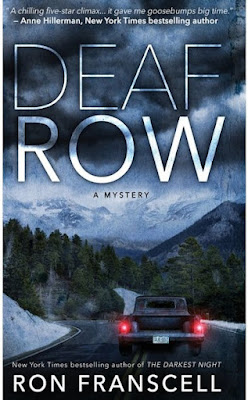Book Review
Review by Robert A. Waters
By the second paragraph of Deaf Row, I was invested. When retired Denver detective Woodrow “Mountain” Bell visits a nursing home in a high-mountain mining town, author Ron Franscell describes the scene: “Pale September twilight swathed the cheerless room as white-haired shadows silently drifted in for dinner, like dust that hadn’t been blown away yet.” At the facility, Bell meets a man whose daughter disappeared decades before. She was later found murdered, with one eye sewn shut. The father has dementia and can only recall brief, flickering remembrances now of his beloved daughter, but Bell is hooked.
In many fiction books, the good writing drops off somewhere in the middle, only to be brought back to life near the end. Not this book. Franscell’s narrative never fails as Bell weaves his way through obscure clue after obscure clue. The former cop enlists help from each of the characters at the restaurant where they meet every morning.
Those friends are drawn with a masterful hand. Each has a colorful background, and the author's witty, fast-paced writing makes them seem alive, if sometimes poignant. For instance, Roxy has discovered the “secret math of solitaire.” He plays the card game for hours every day, trying to master it. Even though the other members of the gang rib him about his obsession, Roxy's mathematical expertise helps Bell develop key information about the killer. And when Bell grows discouraged, Catholic Priest Father Bert Clancy prods the former cop to continue his quest.
Unknown to everyone, the predator lurks nearby, hiding in plain sight. In the unforgiving cold of the mountain town, Bell tracks his prey. The killer’s motives, based on interviews of real serial killers, will leave the reader stunned.
I love it when writers can bring a scene to life. This description of a mountainous road is one of many examples: “The road to the asylum was unearthly. Over the past fifty years, the mountain had reclaimed the steep, bumpy two-track. It was now a barely visible, frozen crease through a narrow gap in the pines.” With those words, I can see that trail crawling up the mountain.
Here is a description of a greasy diner in another mining town: “The mahogany walls—original to the eatery’s opera-house days—were festooned with dozens of old hardhats, each one bearing the name of countless area mines and the name of the miner who wore it. Some dating back to the 1800s weren’t hardhats at all, merely shellac-brimmed derbies with carbide lamps. Seven different calendars from seven random years adorned the place. And slapped across the front of the old-fashioned cash register was a bright red bumper sticker: We’re all here because we’re not all there.”
I can’t say enough about Deaf Row, except that I thoroughly enjoyed it and highly recommend it. Ron Franscell is one of our finest modern literary masters and this book proves it.



